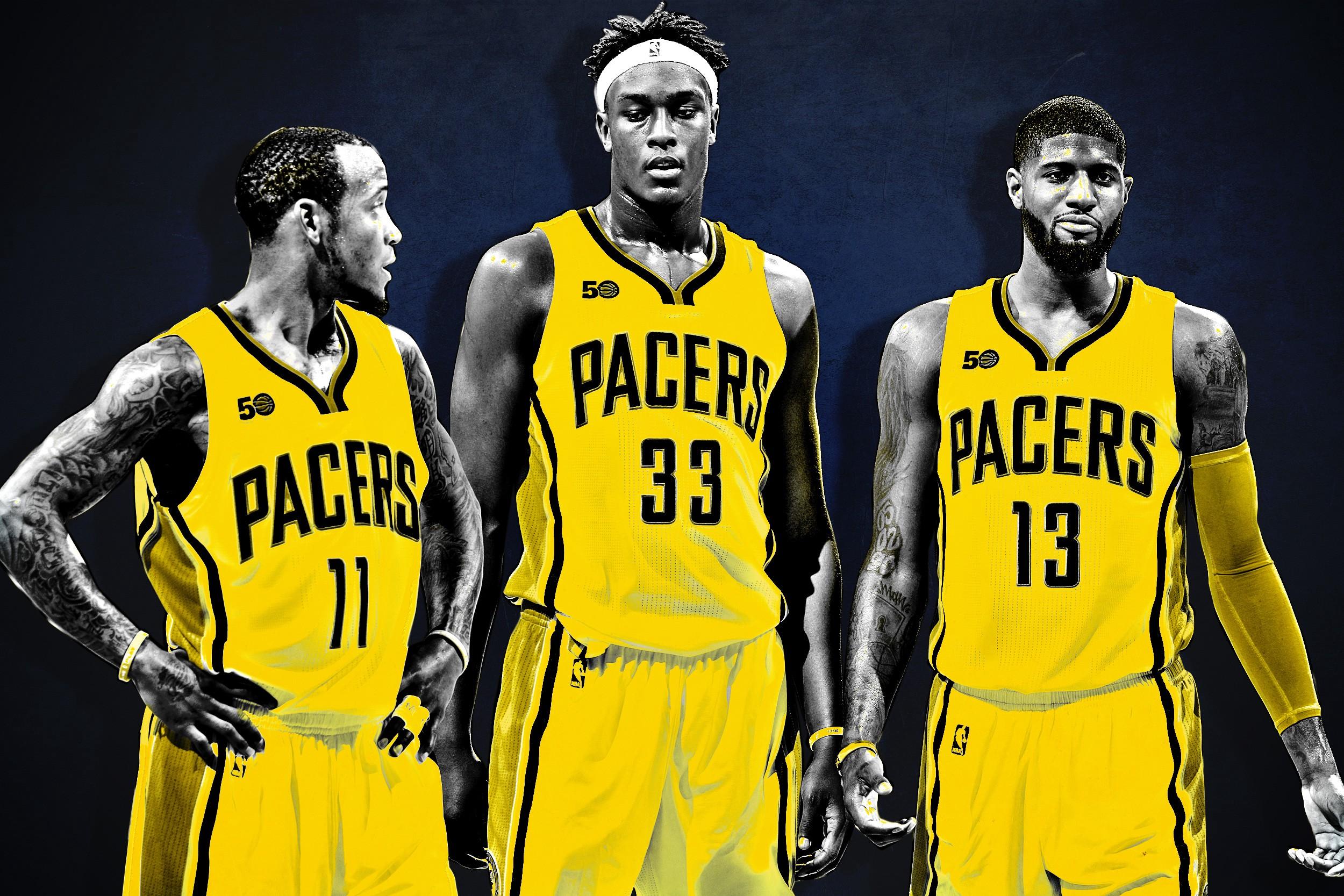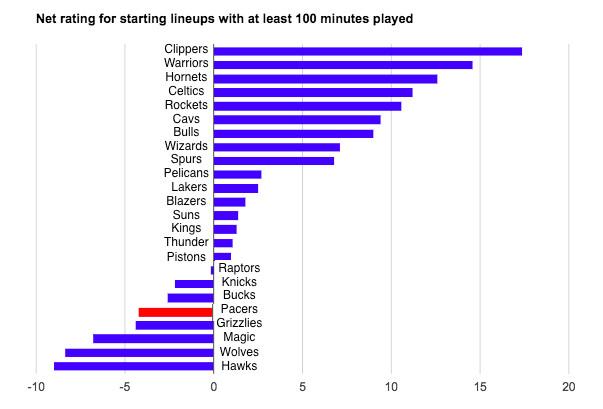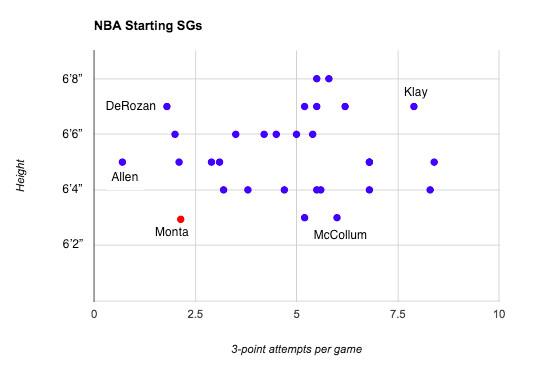
What are we supposed to make of the Pacers? On one hand, they have some of the most impressive wins in the league this season, including two victories over the Clippers by a combined 30 points, as well as a 10-point win over the Cavs. On the other, they have been beaten by some of the worst teams in the NBA — the Nets, 76ers, Suns, and Mavs — with those four losses coming by an average of 10.25 points. Take the average of those extremes and they are right in the middle of the Eastern Conference, in seventh place with a 13–12 record. The most memorable thing that has happened to them this season is being on the wrong end of Klay Thompson’s 60-points-in-29-minutes supernova last week.
The one constant they have been able to count on is the play of Paul George, who is fully recovered from a broken leg that cost him 76 games two seasons ago. George is a legitimate franchise player, a 6-foot-8 do-everything wing who can score, pass, rebound, and defend at a high level. He’s one of the only primary scorers in the NBA who takes the challenge of guarding the opposing team’s primary scorer on a nightly basis, and he can take over a game on offense against any team in the league. He nearly single-handedly beat the Blazers on the second night of a back-to-back on Saturday, with 37 points, five rebounds, three assists, and three steals.
If George is the franchise’s present, Myles Turner is its future. The no. 11 pick in the 2015 draft, Turner has significantly outperformed his draft position in his first two seasons in the league, and he’s one of the prototypes for the changing face of the center position in the NBA. At 6-foot-11 and 243 pounds with a 7-foot-4 wingspan, Turner is an elite shot blocker with the ability to step out to 20-plus feet and knock down perimeter jumpers, and he is adding a 3-point shot to his game. Still only 20 years old, he has barely scratched the surface of his potential and he could be one of the best frontcourt players in the league by the time his rookie contract is up.
In George and Turner, the Pacers have two cornerstones they can build around. But question marks abound in the pieces around them. There has been a lot of upheaval in Indiana over the past two years, as they have transitioned from a half-court team built around the size of Roy Hibbert and David West to a smaller and more offensive-minded group looking to push the pace and play uptempo. George is the only starter left from their Eastern Conference finals teams in 2012 and 2013. West and Hibbert are gone, as are George Hill, Lance Stephenson, and Frank Vogel; Jeff Teague, Monta Ellis, and new head coach Nate McMillan have taken their place.
The additions were supposed to make the Pacers more potent offensively, but through 25 games they have managed only a middling offensive rating at 103.3 points per 100 possessions. While they are playing faster, they don’t do a good job of spreading the floor: Indiana shoots 22.2 3-pointers per game, which means only 25.8 percent of its shot attempts come from behind the arc, one of the five lowest figures in the league. The Pacers have a lot of guys who drive the ball to the rim or can score in the paint, but no one to kick the ball out to. George is their best driver and their best shooter, and he can’t pass the ball to himself. If he gets into the lane, the most dangerous threat from the outside in their starting five is Thaddeus Young, who is shooting an outstanding 46.3 percent from behind the arc, but takes only about two 3s a game. That in itself is an improvement for Young, considering he averages only 1.2 3-point attempts per game for his career.
The Pacers’ best players are all drawn like magnets to the ball, squeezing the amount of space available and making it harder for their offense to function.
Their starting five of Teague, Ellis, George, Young, and Turner features four different players used to having huge roles on offense. It’s a fantasy basketball lineup come to life, but has been a group worth less than the sum of its parts through the first quarter of the season. Among NBA starting lineups with at least 100 minutes played this season, Indiana’s five-man starting unit has the fifth-worst net rating:

The Pacers had a much more balanced starting unit last season, with Hill and Ian Mahinmi complementing George, Ellis, and Turner as off-ball weapons. That group outscored its opponent by 5.2 points per 100 possessions. Mahinmi was a roll man while Hill spotted up at the 3-point line, as the two spent most of their energy on the defensive side of the ball. The Pacers had one of the worst offenses in the NBA last season, but they made the playoffs anyway because they had the third-best defensive rating in the league. They attempted to upgrade their offense in the offseason, but made only marginal improvements on that side of the ball at the cost of capsizing their defense, which has sunk to 19th in the league.
The fit between Teague and Ellis in the backcourt has been particularly awkward. They are both undersized guards who need the ball in their hands and don’t stretch the floor well. The whole point of signing Ellis two seasons ago was to pair him with Hill, a 6-foot-3 floor general who could spot up off the ball and whose 6-foot-9 wingspan allowed him to handle the tougher defensive assignment in the backcourt. Adding Teague moved Ellis off the ball and forced him to guard bigger players, neither of which is a strength of his game. At 6-foot-3 with a below-average wingspan, he’s not built to replicate Hill’s role on this team. Without the length, he’s functionally one of the smallest starting shooting guards in the NBA, and also one of the worst 3-point shooters:
A lack of size and shooting ability is a tough combination for a shooting guard. The players at Ellis’s position who shoot fewer 3s a game are either defensive specialists like Tony Allen or supersized guards who live at the free throw line like DeMar DeRozan. The shooting guards who excel despite their lack of size are either gunners like C.J. McCollum, who make a living bombing 3s, or elite athletes like Avery Bradley, who can defend both backcourt positions. For most of his career, Monta has carved out a niche for himself by being a de facto point guard, distributing the ball and getting to the rim at will. However, at the age of 31, he’s no longer as explosive as he was in his prime, and he doesn’t have the secondary skills necessary to excel in a smaller role. Monta is an all-or-nothing player, and it’s hard for him to help a team if he can’t be a primary option. He has a usage percentage of only 16.4 this season, almost nine points lower than his career average of 25.2.

In theory, it would make sense for McMillan to stagger Ellis’s minutes in order for him to get more time with the ball while playing with the reserves. The problem is Ellis would be running into the exact same problem he has with the starters. The Pacers have Aaron Brooks, Rodney Stuckey, and Al Jefferson on their second unit, and all of them are accustomed to taking a lot of shots. They have six players in their rotation — George, Ellis, Teague, Brooks, Stuckey, and Jefferson — with career usage percentages higher than 23. It’s as if the Pacers’ personnel decisions over the past two years were made with a flow chart that included only one question: can this guy get buckets? If yes, acquire him. If no, who cares. In an era when ball movement is as important as ever, the Pacers’ roster consists almost entirely of one-on-one players.
It’s probably not a coincidence that C.J. Miles, one of the only players with 3-and-D skills in their rotation, has the highest net rating on the team and is one of only three players (along with George and Turner) with a positive net rating on the entire team. Miles is a 6-foot-6 swingman who slides between the SF and PF positions on the second unit; when he’s on the floor, the Pacers outscore their opponent by 5.4 points per 100 possessions. He is shooting 45.3 percent from 3 on 4.8 attempts a game this season, giving the Pacers offense some badly needed oxygen when he is on the floor. Swapping Miles and Ellis would be the easiest way to jump-start the team, but it would also leave them with almost no consistent perimeter options in the second unit.
The Pacers could split the difference by making third-year pro Glenn Robinson III a starter. He’s not as experienced as Miles and he doesn’t take nearly as many 3s per game, but he at least offers the outlines of a 3-and-D skill set at shooting guard. With Ellis sidelined because of a bruised knee, McMillan made that exact adjustment on Monday against the Hornets. Robinson didn’t have a huge game offensively; he scored only three points on two field goal attempts. He did, however, make an impact on defense with six rebounds, a steal, and three blocks in their impressive 110–94 win. It’s only one game, but with Ellis ruled out for at least the next three games, how the Pacers perform in his absence will be something to watch closely. Making any lineup change permanent will be tough; Ellis is one of the most respected players in the locker room, and he has not shown much willingness to take on a sixth-man role over the course of his career.
But the Pacers have to figure something out, because the clock is ticking on George’s contract, which has a player option at the end of next season. George is one of the most talented players set to hit free agency in the next few seasons, and he will have a ton of options if he doesn’t opt to sign another extension with Indiana. He signed his current deal when they were a couple of plays away from making the NBA Finals; today, the Pacers are fighting just to make the playoffs, never mind contend for championships. If Indiana can’t get back to that level in the near future, will George start to get a wandering eye?
The one proven thing that attracts stars in free agency is other stars, and there’s no other player on the Pacers roster who fits that description. The only player who has the potential to become one by 2018 is Turner, but he would still be only 22 years old. The Pacers are hoping Turner can develop fast enough to complement George, a situation that mirrors the Carmelo Anthony–Kristaps Porzingis situation in New York, but in reverse. There are no easy answers for a franchise when the career timetables of its two best players don’t overlap. The Pacers are in a race against time before George hits free agency, but the current makeup of their roster is a cement block holding them in place.

